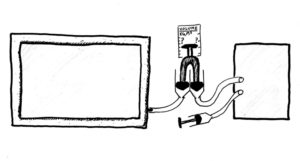
We’re trying to find the volume of the container on the left. First, there is a need to create a system of equations representing the volumes. The linked cylinders will be filled with fluid, to neglect their volume. Let the volume of the measured container be V1, the auxiliary container, V2. Let their pressures be P1 and P2. The atmospheric pressure will be P0. The volume pushed, and remaining volume in the main and auxiliary containers: α, β, and γ respectively. The shift of the cylinder is Δ(γ). Using the fact that pressure times volume is constant for constant temperature, we end up with the following system of equations:
V_1 \cdot P_1 = \alpha \cdot P_0 \\[8pt] V_2 \cdot P_2 = \beta \cdot P_0 \\[8pt] P_1 + P_2 = 2 P_0 \\[8pt] \operatorname \Delta \gamma = \gamma + \alpha – V_1 = \beta – V_2We know that Δ(50mL) = 30mL in the case given, but for a full solution, a general formula will be given here. But in the general case, the known variables are γ and Δ(γ). The third equation provides the first step: divide both sides of it by P0. This is because the value of atmospheric pressure is not relevant, only the ratios to it! We also divide the first and second equations by P0 to complete the switch, removing the irrelevant variable to enable completion of the problem. You may ask why this variable was included in the solution: for completeness; to demonstrate that it’s unimportant. Next: split the fourth equation as shown below. This easily resolves, separating the volumes from the variables. Note that V1 = α + Δ(γ) – γ, so removing it at present is no problem–it can easily be found later.
\alpha = V_1\cdot{P_1 \over P_0} = V_1+\operatorname\Delta\gamma-\gamma \\[8pt] \beta = V_2\cdot{P_2 \over P_0} = V_2+\operatorname\Delta\gamma \phantom{-\gamma}\\[16pt] \alpha-\alpha\cdot{P_1 \over P_0}+\operatorname\Delta\gamma = \gamma \\[8pt] \beta -\beta \cdot{P_2 \over P_0}\phantom{+\operatorname\Delta\gamma} = \gammaCombining the last two equations, it becomes easy to find the one in terms of the other. The equation below describes the simplified relationship without knowing the volume of the auxiliary container. Know that V2 = β + Δ(γ), and as we know that V2 = .5L, so β = .5L – Δ(γ). To solve for this specific case–for to only solve generally and not in the specific case would be just as incomplete as would the opposite–we then fill in our known values of Δ(γ) = 30mL, γ = 50mL, and extending to β = 470mL. We get the value of α = (470mL/30mL – 2)(20mL) ≈ 27.33mL. Remembering from before that V1 = α + Δ(γ) – γ: V1 = ≈27.33mL – 20mL ≈ 7.333mL. The answer is then ≈7.333mL for the specific case and the equation below for the general case.
\alpha = \left(\frac\beta{\operatorname\Delta\gamma}-2\right)\cdot \left(\gamma-\operatorname\Delta\gamma\right)